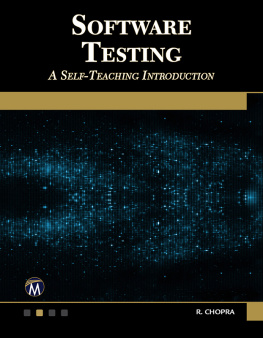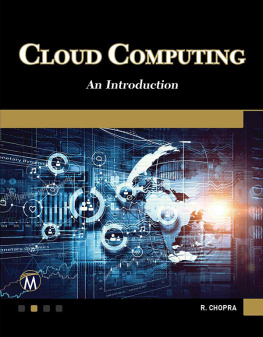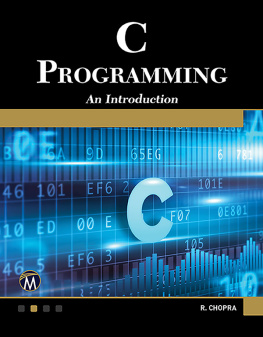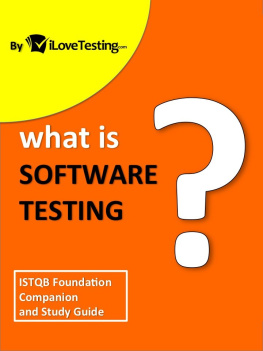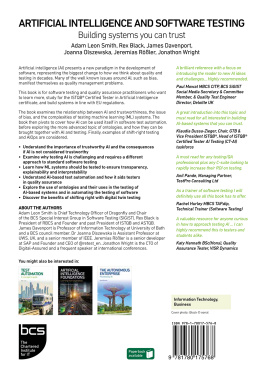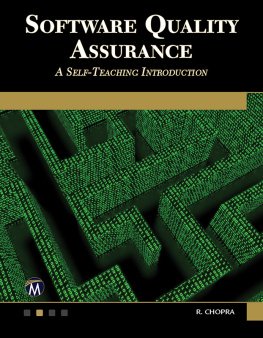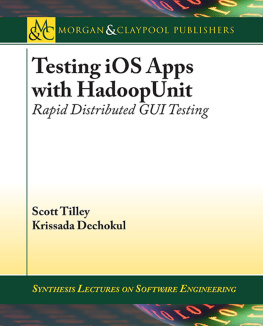Rajiv Chopra - Software Testing
Here you can read online Rajiv Chopra - Software Testing full text of the book (entire story) in english for free. Download pdf and epub, get meaning, cover and reviews about this ebook. publisher: Mercury Learning and Information, genre: Computer. Description of the work, (preface) as well as reviews are available. Best literature library LitArk.com created for fans of good reading and offers a wide selection of genres:
Romance novel
Science fiction
Adventure
Detective
Science
History
Home and family
Prose
Art
Politics
Computer
Non-fiction
Religion
Business
Children
Humor
Choose a favorite category and find really read worthwhile books. Enjoy immersion in the world of imagination, feel the emotions of the characters or learn something new for yourself, make an fascinating discovery.
- Book:Software Testing
- Author:
- Publisher:Mercury Learning and Information
- Genre:
- Rating:4 / 5
- Favourites:Add to favourites
- Your mark:
- 80
- 1
- 2
- 3
- 4
- 5
Software Testing: summary, description and annotation
We offer to read an annotation, description, summary or preface (depends on what the author of the book "Software Testing" wrote himself). If you haven't found the necessary information about the book — write in the comments, we will try to find it.
Software Testing — read online for free the complete book (whole text) full work
Below is the text of the book, divided by pages. System saving the place of the last page read, allows you to conveniently read the book "Software Testing" online for free, without having to search again every time where you left off. Put a bookmark, and you can go to the page where you finished reading at any time.
Font size:
Interval:
Bookmark:
SOFTWARE
TESTING
LICENSE, DISCLAIMER OF LIABILITY, AND LIMITED WARRANTY
By purchasing or using this book (the Work), you agree that this license grants permission to use the contents contained herein, but does not give you the right of ownership to any of the textual content in the book or ownership to any of the information or products contained in it. This license does not permit uploading of the Work onto the Internet or on a network (of any kind) without the written consent of the Publisher. Duplication or dissemination of any text, code, simulations, images, etc. contained herein is limited to and subject to licensing terms for the respective products, and permission must be obtained from the Publisher or the owner of the content, etc., in order to reproduce or network any portion of the textual material (in any media) that is contained in the Work.
MERCURY LEARNING AND INFORMATION (MLI or the Publisher) and anyone involved in the creation, writing, or production of the companion disc, accompanying algorithms, code, or computer programs (the software), and any accompanying Web site or software of the Work, cannot and do not warrant the performance or results that might be obtained by using the contents of the Work. The author, developers, and the Publisher have used their best efforts to insure the accuracy and functionality of the textual material and/or programs contained in this package; we, however, make no warranty of any kind, express or implied, regarding the performance of these contents or programs. The Work is sold as is without warranty (except for defective materials used in manufacturing the book or due to faulty workmanship).
The author, developers, and the publisher of any accompanying content, and anyone involved in the composition, production, and manufacturing of this work will not be liable for damages of any kind arising out of the use of (or the inability to use) the algorithms, source code, computer programs, or textual material contained in this publication. This includes, but is not limited to, loss of revenue or profit, or other incidental, physical, or consequential damages arising out of the use of this Work.
The sole remedy in the event of a claim of any kind is expressly limited to replacement of the book, and only at the discretion of the Publisher. The use of implied warranty and certain exclusions vary from state to state, and might not apply to the purchaser of this product.
SOFTWARE
TESTING
A Self-Teaching Introduction
RAJIV CHOPRA, PhD

MERCURY LEARNING AND INFORMATION
Dulles, Virginia
Boston, Massachusetts
New Delhi
Copyright 2018 by MERCURY LEARNING AND INFORMATION LLC. All rights reserved.
Original Title and Copyright: Software Testing, 4/e. 2014 by S.K. Kataria & Sons.
This publication, portions of it, or any accompanying software may not be reproduced in any way, stored in a retrieval system of any type, or transmitted by any means, media, electronic display or mechanical display, including, but not limited to, photocopy, recording, Internet postings, or scanning, without prior permission in writing from the publisher.
Publisher: David Pallai
MERCURY LEARNING AND INFORMATION
22841 Quicksilver Drive
Dulles, VA 20166
www.merclearning.com
(800) 232-0223
R. Chopra. Software Testing: A Self-Teaching Introduction.
ISBN: 978-1-683921-66-0
The publisher recognizes and respects all marks used by companies, manufacturers, and developers as a means to distinguish their products. All brand names and product names mentioned in this book are trademarks or service marks of their respective companies. Any omission or misuse (of any kind) of service marks or trademarks, etc. is not an attempt to infringe on the property of others.
Library of Congress Control Number: 2017960714
181920321 This book is printed on acid-free paper in the United States of America
Our titles are available for adoption, license, or bulk purchase by institutions, corporations, etc.
For additional information, please contact the Customer Service Dept. at 800-232-0223(toll free).
All of our titles are available in digital format at authorcloudware.com and other digital vendors. The sole obligation of MERCURY LEARNING AND INFORMATION to the purchaser is to replace the book, based on defective materials or faulty workmanship, but not based on the operation or functionality of the product.
CONTENTS
CHAPTER 1
INTRODUCTION TO SOFTWARE TESTING
Inside this Chapter:
1.0. INTRODUCTION
Testing is the process of executing the program with the intent of finding faults. Who should do this testing and when should it start are very important questions that are answered in this text. As we know software testing is the fourth phase of the software development life cycle (SDLC). About 70% of development time is spent on testing. We explore this and many other interesting concepts in this chapter.
1.1. THE TESTING PROCESS
Testing is different from debugging. Removing errors from your programs is known as debugging but testing aims to locate as yet undiscovered errors. We test our programs with both valid and invalid inputs and then compare our expected outputs as well as the observed outputs (after execution of software). Please note that testing starts from the requirements analysis phase only and goes until the last maintenance phase. During requirement analysis and designing we do static testing wherein the SRS is tested to check whether it is as per user requirements or not. We use techniques of code reviews, code inspections, walkthroughs, and software technical reviews (STRs) to do static testing. Dynamic testing starts when the code is ready or even a unit (or module) is ready. It is dynamic testing as now the code is tested. We use various techniques for dynamic testing like black-box, gray-box, and white-box testing. We will be studying these in the subsequent chapters.
1.2. WHAT IS SOFTWARE TESTING?
The concept of software testing has evolved from simple program check-out to a broad set of activities that cover the entire software life-cycle.
There are five distinct levels of testing that are given below:
a. Debug: It is defined as the successful correction of a failure.
b. Demonstrate: The process of showing that major features work with typical input.
c. Verify: The process of finding as many faults in the application under test (AUT) as possible.
d. Validate: The process of finding as many faults in requirements, design, and AUT.
e. Prevent: To avoid errors in development of requirements, design, and implementation by self-checking techniques, including test before design.
There are various definitions of testing that are given below:
Testing is the process of exercising or evaluating a system or system component by manual or automated means to verify that it satisfies specified requirements.
[IEEE 83a]
OR
Software testing is the process of executing a program or system with the intent of finding errors.
[Myers]
OR
It involves any activity aimed at evaluating an attribute or capability of a program or system and determining that it meets its required results.
[Hetzel]
Testing is NOT:
a. The process of demonstrating that errors are not present.
b. The process of showing that a program performs its intended functions correctly.
c. The process of establishing confidence that a program does what it is supposed to do.
So, all these definitions are incorrect. Because, with these as guidelines, one would tend to operate the system in a normal manner to see if it works. One would unconsciously choose such normal/correct test data as would prevent the system from failing. Besides, it is not possible to certify that a system has no errorssimply because it is almost impossible to detect all errors.
Next pageFont size:
Interval:
Bookmark:
Similar books «Software Testing»
Look at similar books to Software Testing. We have selected literature similar in name and meaning in the hope of providing readers with more options to find new, interesting, not yet read works.
Discussion, reviews of the book Software Testing and just readers' own opinions. Leave your comments, write what you think about the work, its meaning or the main characters. Specify what exactly you liked and what you didn't like, and why you think so.

